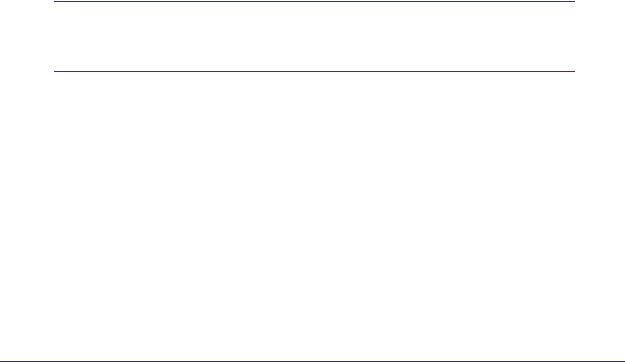NETGEAR M4100-D10-POE, M4100-26-POE, M4100-50G, M4100-12GF, M4100-D12G User Manual
...
ProSafe Managed Switch
Command Line Interface (CLI)
User Manual
10.0.1
M7100-24X
M4100-24G-POE+
M4100-26G
M4100-26-POE
M4100-26G-POE
M4100-50G
M4100-50-POE
M4100-50G-POE+
M4100-12GF
M4100-12G-POE+
M4100-D12G
M4100-D10-POE
M4100-D12G-POE+
350 East Plumeria Drive
San Jose, CA 95134
USA
February 2013 202-11166-02 1.0

ProSafe M4100 and M7100 Managed Switches
Support
Thank you for selecting NETGEAR products.
After installing your device, locate the serial number on the label of your product and use it to register your product at https://my.netgear.com. You must register your product before you can use NETGEAR telephone support. NETGEAR recommends registering your product through the NETGEAR website. For product updates and web support, visit http://support.netgear.com.
Phone (US & Canada only): 1-888-NETGEAR.
Phone (Other Countries): Check the list of phone numbers at http://support.netgear.com/general/contact/default.aspx.
Trademarks
NETGEAR, the NETGEAR logo, and Connect with Innovation are trademarks and/or registered trademarks of NETGEAR, Inc. and/or its subsidiaries in the United States and/or other countries. Information is subject to change without notice. © NETGEAR, Inc. All rights reserved.
Revision History
Publication Part Number |
Version |
Publish Date |
Comments |
|
|
|
|
202-11166-02 |
1.0 |
February 2013 |
Updated document. |
|
|
|
|
202-11166-01 |
1.0 |
October 2012 |
First publication. |
|
|
|
|
2

Contents
Chapter 1 Using the Command-Line Interface
Licensing and Command Support . . . . . . . . . . . . . . . . . . . . . . . . . . . . . . . . 8
Command Syntax . . . . . . . . . . . . . . . . . . . . . . . . . . . . . . . . . . . . . . . . . . . . . 9
Command Conventions . . . . . . . . . . . . . . . . . . . . . . . . . . . . . . . . . . . . . . . . 9
Common Parameter Values . . . . . . . . . . . . . . . . . . . . . . . . . . . . . . . . . . . . 10
Slot/Port Naming Convention . . . . . . . . . . . . . . . . . . . . . . . . . . . . . . . . . . . 11
Using a Command’s “No” Form . . . . . . . . . . . . . . . . . . . . . . . . . . . . . . . . . 12
Managed Switch Modules . . . . . . . . . . . . . . . . . . . . . . . . . . . . . . . . . . . . . 12
Command Modes . . . . . . . . . . . . . . . . . . . . . . . . . . . . . . . . . . . . . . . . . . . . 12
Command Completion and Abbreviation . . . . . . . . . . . . . . . . . . . . . . . . . . 16
CLI Error Messages . . . . . . . . . . . . . . . . . . . . . . . . . . . . . . . . . . . . . . . . . . 16
CLI Line-Editing Conventions . . . . . . . . . . . . . . . . . . . . . . . . . . . . . . . . . . . 17
Using CLI Help . . . . . . . . . . . . . . . . . . . . . . . . . . . . . . . . . . . . . . . . . . . . . . 17
Accessing the CLI. . . . . . . . . . . . . . . . . . . . . . . . . . . . . . . . . . . . . . . . . . . . 18
Chapter 2 Switching Commands
Port Configuration Commands . . . . . . . . . . . . . . . . . . . . . . . . . . . . . . . . . . 21
Loopback Interface Commands . . . . . . . . . . . . . . . . . . . . . . . . . . . . . . . . . 27
Spanning Tree Protocol (STP) Commands . . . . . . . . . . . . . . . . . . . . . . . . 30
VLAN Commands. . . . . . . . . . . . . . . . . . . . . . . . . . . . . . . . . . . . . . . . . . . . 47
Double VLAN Commands . . . . . . . . . . . . . . . . . . . . . . . . . . . . . . . . . . . . . 60
Voice VLAN Commands. . . . . . . . . . . . . . . . . . . . . . . . . . . . . . . . . . . . . . . 63
Provisioning (IEEE 802.1p) Commands . . . . . . . . . . . . . . . . . . . . . . . . . . . 65
Protected Ports Commands . . . . . . . . . . . . . . . . . . . . . . . . . . . . . . . . . . . . 65
Private VLAN . . . . . . . . . . . . . . . . . . . . . . . . . . . . . . . . . . . . . . . . . . . . . . . 68
GARP Commands . . . . . . . . . . . . . . . . . . . . . . . . . . . . . . . . . . . . . . . . . . . 71
GVRP Commands . . . . . . . . . . . . . . . . . . . . . . . . . . . . . . . . . . . . . . . . . . . 73
GMRP Commands . . . . . . . . . . . . . . . . . . . . . . . . . . . . . . . . . . . . . . . . . . . 75
Port-Based Network Access Control Commands. . . . . . . . . . . . . . . . . . . . 77
802.1X Supplicant Commands . . . . . . . . . . . . . . . . . . . . . . . . . . . . . . . . . . 91
Storm-Control Commands . . . . . . . . . . . . . . . . . . . . . . . . . . . . . . . . . . . . . 94
Flow Control Commands . . . . . . . . . . . . . . . . . . . . . . . . . . . . . . . . . . . . . 104
Port-Channel/LAG (802.3ad) Commands . . . . . . . . . . . . . . . . . . . . . . . . 105
Port Mirroring . . . . . . . . . . . . . . . . . . . . . . . . . . . . . . . . . . . . . . . . . . . . . . 121
Static MAC Filtering . . . . . . . . . . . . . . . . . . . . . . . . . . . . . . . . . . . . . . . . . 123
DHCP L2 Relay Agent Commands . . . . . . . . . . . . . . . . . . . . . . . . . . . . . 127
DHCP Client Commands . . . . . . . . . . . . . . . . . . . . . . . . . . . . . . . . . . . . . 131
DHCP Snooping Configuration Commands . . . . . . . . . . . . . . . . . . . . . . . 132
Dynamic ARP Inspection Commands . . . . . . . . . . . . . . . . . . . . . . . . . . . 141
3

ProSafe M4100 and M7100 Managed Switches
IGMP Snooping Configuration Commands . . . . . . . . . . . . . . . . . . . . . . . 148
IGMP Snooping Querier Commands . . . . . . . . . . . . . . . . . . . . . . . . . . . . 157
MLD Snooping Commands . . . . . . . . . . . . . . . . . . . . . . . . . . . . . . . . . . . 161
MLD Snooping Querier Commands . . . . . . . . . . . . . . . . . . . . . . . . . . . . . 168
set mld querier . . . . . . . . . . . . . . . . . . . . . . . . . . . . . . . . . . . . . . . . . . . 168
set mld querier query_interval . . . . . . . . . . . . . . . . . . . . . . . . . . . . . . . 169
set mld querier timer expiry . . . . . . . . . . . . . . . . . . . . . . . . . . . . . . . . . 169
set mld querier election participate. . . . . . . . . . . . . . . . . . . . . . . . . . . . 170
show mldsnooping querier . . . . . . . . . . . . . . . . . . . . . . . . . . . . . . . . . . 170
Port Security Commands . . . . . . . . . . . . . . . . . . . . . . . . . . . . . . . . . . . . . 171
LLDP (802.1AB) Commands . . . . . . . . . . . . . . . . . . . . . . . . . . . . . . . . . . 175
LLDP-MED Commands . . . . . . . . . . . . . . . . . . . . . . . . . . . . . . . . . . . . . . 184
Denial of Service Commands. . . . . . . . . . . . . . . . . . . . . . . . . . . . . . . . . . 193
MAC Database Commands . . . . . . . . . . . . . . . . . . . . . . . . . . . . . . . . . . . 203
ISDP Commands . . . . . . . . . . . . . . . . . . . . . . . . . . . . . . . . . . . . . . . . . . . 205
Priority-Based Flow Control Commands . . . . . . . . . . . . . . . . . . . . . . . . . 210
Chapter 3 Multicast VLAN Registration (MVR)
About MVR . . . . . . . . . . . . . . . . . . . . . . . . . . . . . . . . . . . . . . . . . . . . . . . . 214
MVR Commands . . . . . . . . . . . . . . . . . . . . . . . . . . . . . . . . . . . . . . . . . . . 214
Chapter 4 Routing Commands
Address Resolution Protocol (ARP) Commands . . . . . . . . . . . . . . . . . . . 222
IP Routing Commands . . . . . . . . . . . . . . . . . . . . . . . . . . . . . . . . . . . . . . . 227
Router Discovery Protocol Commands . . . . . . . . . . . . . . . . . . . . . . . . . . 244
Virtual LAN Routing Commands . . . . . . . . . . . . . . . . . . . . . . . . . . . . . . . 248
Virtual Router Redundancy Protocol Commands. . . . . . . . . . . . . . . . . . . 249
DHCP and BOOTP Relay Commands . . . . . . . . . . . . . . . . . . . . . . . . . . . 257
IP Helper Commands . . . . . . . . . . . . . . . . . . . . . . . . . . . . . . . . . . . . . . . . 259
Open Shortest Path First (OSPF) Commands . . . . . . . . . . . . . . . . . . . . . 263
OSPF Graceful Restart Commands . . . . . . . . . . . . . . . . . . . . . . . . . . . . . 304
nsf. . . . . . . . . . . . . . . . . . . . . . . . . . . . . . . . . . . . . . . . . . . . . . . . . . . . . 305
nsf restart-interval. . . . . . . . . . . . . . . . . . . . . . . . . . . . . . . . . . . . . . . . . 305
nsf helper . . . . . . . . . . . . . . . . . . . . . . . . . . . . . . . . . . . . . . . . . . . . . . . 306
nsf helper disable . . . . . . . . . . . . . . . . . . . . . . . . . . . . . . . . . . . . . . . . . 307
nsf [ietf] helper strict-lsa-checking . . . . . . . . . . . . . . . . . . . . . . . . . . . . 307
OSPF Interface Flap Dampening Commands . . . . . . . . . . . . . . . . . . . . . 309
Routing Information Protocol (RIP) Commands . . . . . . . . . . . . . . . . . . . . 311
ICMP Throttling Commands . . . . . . . . . . . . . . . . . . . . . . . . . . . . . . . . . . . 318
Chapter 5 IP Multicast Commands
Multicast Commands . . . . . . . . . . . . . . . . . . . . . . . . . . . . . . . . . . . . . . . . 321
DVMRP Commands . . . . . . . . . . . . . . . . . . . . . . . . . . . . . . . . . . . . . . . . . 326
PIM Commands . . . . . . . . . . . . . . . . . . . . . . . . . . . . . . . . . . . . . . . . . . . . 331
Internet Group Message Protocol (IGMP) Commands . . . . . . . . . . . . . . 342
IGMP Proxy Commands. . . . . . . . . . . . . . . . . . . . . . . . . . . . . . . . . . . . . . 349
4

ProSafe M4100 and M7100 Managed Switches
Chapter 6 IPv6 Commands
Tunnel Interface Commands . . . . . . . . . . . . . . . . . . . . . . . . . . . . . . . . . .356
IPv6 Routing Commands . . . . . . . . . . . . . . . . . . . . . . . . . . . . . . . . . . . . .357
OSPFv3 Commands. . . . . . . . . . . . . . . . . . . . . . . . . . . . . . . . . . . . . . . . .380
OSPFv3 Graceful Restart Commands . . . . . . . . . . . . . . . . . . . . . . . . . . .411
DHCPv6 Commands . . . . . . . . . . . . . . . . . . . . . . . . . . . . . . . . . . . . . . . .413
Chapter 7 IPv6 Multicast Commands
IPv6 Multicast Forwarder Commands . . . . . . . . . . . . . . . . . . . . . . . . . . .422
IPv6 PIM Commands . . . . . . . . . . . . . . . . . . . . . . . . . . . . . . . . . . . . . . . .424
IPv6 MLD Commands . . . . . . . . . . . . . . . . . . . . . . . . . . . . . . . . . . . . . . .431
IPv6 MLD-Proxy Commands . . . . . . . . . . . . . . . . . . . . . . . . . . . . . . . . . .437
Chapter 8 Quality of Service (QoS) Commands
Class of Service (CoS) Commands . . . . . . . . . . . . . . . . . . . . . . . . . . . . .444 Differentiated Services (DiffServ) Commands . . . . . . . . . . . . . . . . . . . . .451 DiffServ Class Commands . . . . . . . . . . . . . . . . . . . . . . . . . . . . . . . . . . . .452 DiffServ Policy Commands. . . . . . . . . . . . . . . . . . . . . . . . . . . . . . . . . . . .461 DiffServ Service Commands . . . . . . . . . . . . . . . . . . . . . . . . . . . . . . . . . .466 DiffServ Show Commands . . . . . . . . . . . . . . . . . . . . . . . . . . . . . . . . . . . .468 MAC Access Control List (ACL) Commands . . . . . . . . . . . . . . . . . . . . . .473 IP Access Control List (ACL) Commands. . . . . . . . . . . . . . . . . . . . . . . . .478 IPv6 Access Control List (ACL) Commands. . . . . . . . . . . . . . . . . . . . . . .484 Time Range Commands for Time-Based ACLs . . . . . . . . . . . . . . . . . . . .488 AutoVOIP . . . . . . . . . . . . . . . . . . . . . . . . . . . . . . . . . . . . . . . . . . . . . . . . .490 iSCSI Commands . . . . . . . . . . . . . . . . . . . . . . . . . . . . . . . . . . . . . . . . . . .494
Chapter 9 Power over Ethernet (PoE) Commands
About PoE . . . . . . . . . . . . . . . . . . . . . . . . . . . . . . . . . . . . . . . . . . . . . . . .501
PoE Commands . . . . . . . . . . . . . . . . . . . . . . . . . . . . . . . . . . . . . . . . . . . .502
Chapter 10 Utility Commands
Auto Install Commands . . . . . . . . . . . . . . . . . . . . . . . . . . . . . . . . . . . . . .513
Dual Image Commands . . . . . . . . . . . . . . . . . . . . . . . . . . . . . . . . . . . . . .515
System Information and Statistics Commands. . . . . . . . . . . . . . . . . . . . .517
Logging Commands . . . . . . . . . . . . . . . . . . . . . . . . . . . . . . . . . . . . . . . . .534
Email Alerting and Mail Server Commands . . . . . . . . . . . . . . . . . . . . . . .539
System Utility and Clear Commands . . . . . . . . . . . . . . . . . . . . . . . . . . . .546
Simple Network Time Protocol (SNTP) Commands. . . . . . . . . . . . . . . . .556
DHCP Server Commands . . . . . . . . . . . . . . . . . . . . . . . . . . . . . . . . . . . .564
DNS Client Commands . . . . . . . . . . . . . . . . . . . . . . . . . . . . . . . . . . . . . .575
Packet Capture Commands . . . . . . . . . . . . . . . . . . . . . . . . . . . . . . . . . . .580
Serviceability Packet Tracing Commands . . . . . . . . . . . . . . . . . . . . . . . .583
Cable Test Command. . . . . . . . . . . . . . . . . . . . . . . . . . . . . . . . . . . . . . . .603
sFlow Commands. . . . . . . . . . . . . . . . . . . . . . . . . . . . . . . . . . . . . . . . . . .604
5

ProSafe M4100 and M7100 Managed Switches
Software License Commands . . . . . . . . . . . . . . . . . . . . . . . . . . . . . . . . . 609 IP Address Conflict Commands . . . . . . . . . . . . . . . . . . . . . . . . . . . . . . . . 610 Link Local Protocol Filtering Commands . . . . . . . . . . . . . . . . . . . . . . . . . 611 RMON Stats and History Commands. . . . . . . . . . . . . . . . . . . . . . . . . . . . 612 UDLD Commands . . . . . . . . . . . . . . . . . . . . . . . . . . . . . . . . . . . . . . . . . . 618 USB commands . . . . . . . . . . . . . . . . . . . . . . . . . . . . . . . . . . . . . . . . . . . . 620
Chapter 11 Management Commands
Configuring the Switch Management CPU. . . . . . . . . . . . . . . . . . . . . . . . 624
Network Interface Commands . . . . . . . . . . . . . . . . . . . . . . . . . . . . . . . . . 626
Console Port Access Commands. . . . . . . . . . . . . . . . . . . . . . . . . . . . . . . 629
Telnet Commands . . . . . . . . . . . . . . . . . . . . . . . . . . . . . . . . . . . . . . . . . . 631
Secure Shell (SSH) Commands. . . . . . . . . . . . . . . . . . . . . . . . . . . . . . . . 636
Management Security Commands . . . . . . . . . . . . . . . . . . . . . . . . . . . . . . 639
Hypertext Transfer Protocol (HTTP) Commands . . . . . . . . . . . . . . . . . . . 640
Access Commands . . . . . . . . . . . . . . . . . . . . . . . . . . . . . . . . . . . . . . . . . 647
User Account Commands . . . . . . . . . . . . . . . . . . . . . . . . . . . . . . . . . . . . 647
SNMP Commands . . . . . . . . . . . . . . . . . . . . . . . . . . . . . . . . . . . . . . . . . . 670
RADIUS Commands . . . . . . . . . . . . . . . . . . . . . . . . . . . . . . . . . . . . . . . . 680
TACACS+ Commands . . . . . . . . . . . . . . . . . . . . . . . . . . . . . . . . . . . . . . . 693
Configuration Scripting Commands . . . . . . . . . . . . . . . . . . . . . . . . . . . . . 698
Pre-Login Banner and System Prompt Commands . . . . . . . . . . . . . . . . . 700
Switch Database Management (SDM) Templates . . . . . . . . . . . . . . . . . . 701
IPv6 Management Commands. . . . . . . . . . . . . . . . . . . . . . . . . . . . . . . . . 703
Chapter 12 Log Messages
Core . . . . . . . . . . . . . . . . . . . . . . . . . . . . . . . . . . . . . . . . . . . . . . . . . . . . . 709
Utilities . . . . . . . . . . . . . . . . . . . . . . . . . . . . . . . . . . . . . . . . . . . . . . . . . . . 711
Management . . . . . . . . . . . . . . . . . . . . . . . . . . . . . . . . . . . . . . . . . . . . . . 713
Switching . . . . . . . . . . . . . . . . . . . . . . . . . . . . . . . . . . . . . . . . . . . . . . . . . 717
QoS . . . . . . . . . . . . . . . . . . . . . . . . . . . . . . . . . . . . . . . . . . . . . . . . . . . . . 723
Routing/IPv6 Routing . . . . . . . . . . . . . . . . . . . . . . . . . . . . . . . . . . . . . . . . 724
Multicast . . . . . . . . . . . . . . . . . . . . . . . . . . . . . . . . . . . . . . . . . . . . . . . . . . 727
Stacking . . . . . . . . . . . . . . . . . . . . . . . . . . . . . . . . . . . . . . . . . . . . . . . . . . 729
Technologies . . . . . . . . . . . . . . . . . . . . . . . . . . . . . . . . . . . . . . . . . . . . . . 730
O/S Support . . . . . . . . . . . . . . . . . . . . . . . . . . . . . . . . . . . . . . . . . . . . . . . 732
Chapter 13 Green Ethernet Commands
Energy-Detect Mode . . . . . . . . . . . . . . . . . . . . . . . . . . . . . . . . . . . . . . . . 735
Energy Efficient Ethernet (EEE) . . . . . . . . . . . . . . . . . . . . . . . . . . . . . . . . 735
Chapter 14 Command List
6

1. Using the Command-Line Interface |
1 |
|
|
||
|
|
|
The command-line interface (CLI) is a text-based way to manage and monitor the system. You can access the CLI by using a direct serial connection or by using a remote logical connection with telnet or SSH.
This chapter describes the CLI syntax, conventions, and modes. It contains the following sections:
•Licensing and Command Support
•Command Syntax
•Command Conventions
•Common Parameter Values
•Slot/Port Naming Convention
•Using a Command’s “No” Form
•Managed Switch Modules
•Command Modes
•Command Completion and Abbreviation
•CLI Error Messages
•CLI Line-Editing Conventions
•Using CLI Help
•Accessing the CLI
7

ProSafe M4100 and M7100 Managed Switches
Licensing and Command Support
As shown in the following table, some command groups, or commands, require a license and some are supported on particular switch models. For those requiring a license, license keys are available from your VAR or NETGEAR authorized e-commerce portal. License activation is described in the Software Setup Manual.
Command Group or Command |
M4100 |
M7100 |
|
|
|
Router Discovery Protocol Commands |
Not supported |
Not supported |
|
|
|
Virtual Router Redundancy Protocol Commands |
Not supported |
Not supported |
|
|
|
Open Shortest Path First (OSPF) Commands |
Not supported |
Not supported |
|
|
|
OSPF Graceful Restart Commands |
Not supported |
Not supported |
|
|
|
Routing Information Protocol (RIP) Commands |
Not supported |
Not supported |
|
|
|
Tunnel Interface Commands |
Not supported |
Not supported |
|
|
|
IPv6 Routing Commands |
Not supported |
Not supported |
|
|
|
OSPFv3 Commands |
Not supported |
Not supported |
|
|
|
OSPFv3 Graceful Restart Commands |
Not supported |
Not supported |
|
|
|
DHCPv6 Commands |
Not supported |
Not supported |
|
|
|
Multicast Commands |
Not supported |
Not supported |
|
|
|
DVMRP Commands |
Not supported |
Not supported |
|
|
|
PIM Commands |
Not supported |
Not supported |
|
|
|
Internet Group Message Protocol (IGMP) Commands |
Not supported |
Not supported |
|
|
|
IGMP Proxy Commands |
Not supported |
Not supported |
|
|
|
IPv6 Multicast Forwarder Commands |
Not supported |
Not supported |
|
|
|
IPv6 PIM Commands |
Not supported |
Not supported |
|
|
|
IPv6 MLD Commands |
Not supported |
Not supported |
|
|
|
IPv6 MLD-Proxy Commands |
Not supported |
Not supported |
|
|
|
PoE Commands |
Supported on PoE |
Not supported |
|
models only |
|
|
|
|
MVR Commands |
Supported |
Supported |
|
|
|
Link Local Protocol Filtering Commands |
Not supported |
Supported |
|
|
|
Priority-Based Flow Control Commands |
Not Supported |
Not supported |
|
|
|
cos-queue random-detect |
Supported |
Supported |
|
|
|
no cos-queue random-detect |
Supported |
Supported |
|
|
|
random-detect exponential weighting-constant |
Supported |
Supported |
|
|
|
no random-detect exponential weighting-constant |
Supported |
Supported |
|
|
|
Using the Command-Line Interface
8

ProSafe M4100 and M7100 Managed Switches
Command Group or Command |
M4100 |
M7100 |
|
|
|
random-detect queue-parms |
Supported |
Supported |
|
|
|
no random-detect queue-parms |
Supported |
Supported |
|
|
|
Command Syntax
A command is one or more words that might be followed by one or more parameters. Parameters can be required or optional values.
Some commands, such as show network or clear vlan, do not require parameters. Other commands, such as network parms, require that you supply a value after the command. You must type the parameter values in a specific order, and optional parameters follow required parameters. The following example describes the network parms command syntax:
Format network parms <ipaddr> <netmask> [gateway]
•network parms is the command name.
•<ipaddr> and <netmask> are parameters and represent required values that you must enter after you type the command keywords.
•[gateway] is an optional parameter, so you are not required to enter a value in place of the parameter.
The New Template User Manual lists each command by the command name and provides a brief description of the command. Each command reference also contains the following information:
•Format shows the command keywords and the required and optional parameters.
•Mode identifies the command mode you must be in to access the command.
•Default shows the default value, if any, of a configurable setting on the device.
The show commands also contain a description of the information that the command shows.
Command Conventions
In this document, the command name is in bold font. Parameters are in italic font. You must replace the parameter name with an appropriate value, which might be a name or number. Parameters are order-dependent.
Using the Command-Line Interface
9

ProSafe M4100 and M7100 Managed Switches
The parameters for a command might include mandatory values, optional values, or keyword choices. Table 1 describes the conventions this document uses to distinguish between value types.
Table 1. Parameter Conventions
Symbol |
Example |
Description |
|
|
|
<> angle brackets |
<value> |
Indicates that you must enter a value in place of the |
|
|
brackets and text inside them. |
|
|
|
[] square brackets |
[value] |
Indicates an optional parameter that you can enter in |
|
|
place of the brackets and text inside them. |
|
|
|
{} curly braces |
{choice1 | |
Indicates that you must select a parameter from the list of |
|
choice2} |
choices. |
| Vertical bars |
choice1 | choice2 |
Separates the mutually exclusive choices. |
|
|
|
[{}] Braces within |
[{choice1 | |
Indicates a choice within an optional element. |
square brackets |
choice2}] |
|
Common Parameter Values
Parameter values might be names (strings) or numbers. To use spaces as part of a name parameter, enclose the name value in double quotes. For example, the expression “System Name with Spaces” forces the system to accept the spaces. Empty strings (““) are not valid user-defined strings. Table 2 describes common parameter values and value formatting.
Table 2. Parameter Descriptions
Parameter |
Description |
|
|
ipaddr |
This parameter is a valid IP address. You can enter the IP address in the following formats: |
|
a (32 bits) |
|
a.b (8.24 bits) |
|
a.b.c (8.8.16 bits) |
|
a.b.c.d (8.8.8.8) |
|
In addition to these formats, the CLI accepts decimal, hexadecimal, and octal formats |
|
through the following input formats (where n is any valid hexadecimal, octal, or decimal |
|
number): |
|
0xn (CLI assumes hexadecimal format) |
|
0n (CLI assumes octal format with leading zeros) |
|
n (CLI assumes decimal format) |
ipv6-address |
FE80:0000:0000:0000:020F:24FF:FEBF:DBCB, or |
|
FE80:0:0:0:20F:24FF:FEBF:DBCB, or |
|
FE80::20F24FF:FEBF:DBCB, or |
|
FE80:0:0:0:20F:24FF:128:141:49:32 |
|
For more information, refer to RFC 3513. |
|
|
Interface or |
Valid slot and port number separated by forward slashes. For example, 0/1 represents slot |
slot/port |
number 0 and port number 1. |
|
|
Using the Command-Line Interface
10

ProSafe M4100 and M7100 Managed Switches
Table 2. Parameter Descriptions (Continued)
Parameter |
Description |
|
|
Logical Interface |
Represents a logical slot and port number. This is applicable in the case of a port-channel |
|
(LAG). You can use the logical slot/port to configure the port-channel. |
Character strings |
Use double quotation marks to identify character strings, for example, “System Name with |
|
Spaces”. An empty string (“”) is not valid. |
|
|
Slot/Port Naming Convention
Managed switch software references physical entities such as cards and ports by using a slot/port naming convention. The software also uses this convention to identify certain logical entities, such as Port-Channel interfaces.
The slot number has two uses. In the case of physical ports, it identifies the card containing the ports. In the case of logical and CPU ports it also identifies the type of interface or port.
Table 3. Type of Slots
Slot Type |
Description |
|
|
Physical slot numbers |
Physical slot numbers begin with zero, and are allocated up to the maximum |
|
number of physical slots. |
|
|
Logical slot numbers |
Logical slots immediately follow physical slots and identify port-channel (LAG) or |
|
router interfaces. |
|
|
CPU slot numbers |
The CPU slots immediately follow the logical slots. |
|
|
The port identifies the specific physical port or logical interface being managed on a given slot.
Table 4. Type of Ports
Port Type |
Description |
|
|
Physical Ports |
The physical ports for each slot are numbered sequentially starting from zero. |
|
|
Logical Interfaces |
Port-channel or link aggregation group (LAG) interfaces are logical interfaces that |
|
are only used for bridging functions. |
|
VLAN routing interfaces are only used for routing functions. |
|
Loopback interfaces are logical interfaces that are always up. |
|
Tunnel interfaces are logical point-to-point links that carry encapsulated packets. |
|
|
CPU ports |
CPU ports are handled by the driver as one or more physical entities located on |
|
physical slots. |
Using the Command-Line Interface
11

ProSafe M4100 and M7100 Managed Switches
Note: In the CLI, loopback and tunnel interfaces do not use the slot/port format. To specify a loopback interface, you use the loopback ID. To specify a tunnel interface, you use the tunnel ID.
Using a Command’s “No” Form
The no keyword is a specific form of an existing command and does not represent a new or distinct command. Almost every configuration command has a no form. In general, use the no form to reverse the action of a command or reset a value back to the default. For example, the no shutdown configuration command reverses the shutdown of an interface. Use the command without the keyword no to reenable a disabled feature or to enable a feature that is disabled by default. Only the configuration commands are available in the no form.
Managed Switch Modules
Managed switch software consists of flexible modules that can be applied in various combinations to develop advanced Layer 2/3/4+ products. The commands and command modes available on your switch depend on the installed modules. Additionally, for some show commands, the output fields might change based on the modules included in the software.
The software suite includes the following modules:
•Switching (Layer 2)
•Routing (Layer 3)
•IPv6—IPv6 routing
•Multicast
•Quality of Service
•Management (CLI, web UI, and SNMP)
•IPv6 Management—Allows management of the device through an IPv6 through an IPv6 address without requiring the IPv6 Routing package in the system. The management address can be associated with the network port (front-panel switch ports) and a routine interface (port or VLAN).
•Stacking
Not all modules are available for all platforms or software releases.
Command Modes
The CLI groups commands into modes according to the command function. Each of the command modes supports specific software commands. The commands in one mode are not available until you switch to that particular mode, except for the User EXEC mode
Using the Command-Line Interface
12

ProSafe M4100 and M7100 Managed Switches
commands. You can execute the User EXEC mode commands in the Privileged EXEC mode.
The command prompt changes in each command mode to help you identify the current mode. Table 5 describes the command modes and the prompts visible in that mode.
Note: The command modes available on your switch depend on the software modules that are installed. For example, a switch that does not support BGPv4 does not have the Router BGPv4 Command Mode.
Table 5. CLI Command Modes
Command Mode |
Prompt |
Mode Description |
|
|
|
User EXEC |
Switch> |
Contains a limited set of commands to view |
|
|
basic system information. |
|
|
|
Privileged EXEC |
Switch# |
Allows you to issue any EXEC command, enter |
|
|
the VLAN mode, or enter the Global |
|
|
Configuration mode. |
|
|
|
Global Config |
Switch (Config)# |
Groups general setup commands and permits |
|
|
you to make modifications to the running |
|
|
configuration. |
|
|
|
VLAN Config |
Switch (Vlan)# |
Groups all the VLAN commands. |
|
|
|
Interface Config |
Switch (Interface <slot/port>)# |
Manages the operation of an interface and |
|
|
provides access to the router interface |
|
Switch (Interface Loopback <id>)# |
configuration commands. |
|
Use this mode to set up a physical port for a |
|
|
|
|
|
Switch (Interface Tunnel <id>)# |
specific logical connection operation. |
|
|
|
|
|
|
Line Config |
Switch (line)# |
Contains commands to configure outbound |
|
|
telnet settings and console interface settings. |
|
|
|
Policy Map |
Switch (Config-policy-map)# |
Contains the QoS Policy-Map configuration |
Config |
|
commands. |
|
|
|
Policy Class |
Switch (Config-policy-class-map)# |
Consists of class creation, deletion, and |
Config |
|
matching commands. The class match |
|
|
commands specify Layer 2, Layer 3, and |
|
|
general match criteria. |
|
|
|
Class Map Config |
Switch (Config-class-map)# |
Contains the QoS class map configuration |
|
|
commands for IPv4. |
|
|
|
Ipv6_Class-Map |
Switch (Config-class-map)# |
Contains the QoS class map configuration |
Config |
|
commands for IPv6. |
Using the Command-Line Interface
13

ProSafe M4100 and M7100 Managed Switches
Table 5. CLI Command Modes (Continued)
Command Mode |
Prompt |
Mode Description |
|
|
|
Router OSPF |
Switch (Config-router)# |
Contains the OSPF configuration commands. |
Config |
|
|
|
|
|
Router OSPFv3 |
Switch (Config rtr)# |
Contains the OSPFv3 configuration commands. |
Config |
|
|
|
|
|
Router RIP Config |
Switch (Config-router)# |
Contains the RIP configuration commands. |
|
|
|
MAC Access-list |
Switch (Config-mac-access-list)# |
Allows you to create a MAC Access-List and to |
Config |
|
enter the mode containing MAC Access-List |
|
|
configuration commands. |
|
|
|
TACACS Config |
Switch (Tacacs)# |
Contains commands to configure properties for |
|
|
the TACACS servers. |
|
|
|
DHCP Pool |
Switch (Config dhcp-pool)# |
Contains the DHCP server IP address pool |
Config |
|
configuration commands. |
|
|
|
DHCPv6 Pool |
Switch (Config dhcp6-pool)# |
Contains the DHCPv6 server IPv6 address pool |
Config |
|
configuration commands. |
|
|
|
Stack Global |
Switch (Config stack)# |
Allows you to access the Stack Global Config |
Config Mode |
|
Mode. |
|
|
|
ARP Access-List |
Switch (Config-arp-access-list)# |
Contains commands to add ARP ACL rules in |
Config Mode |
|
an ARP Access List. |
|
|
|
Table 6 explains how to enter or exit each mode.
Table 6. CLI Mode Access and Exit
Command Mode |
Access Method |
Exit or Access Previous Mode |
User EXEC |
This is the first level of access. |
To exit, enter logout. |
Privileged EXEC |
From the User EXEC mode, enter |
To exit to the User EXEC mode, enter exit or |
|
enable. |
press Ctrl-Z. |
Global Config |
From the Privileged EXEC mode, |
To exit to the Privileged EXEC mode, enter exit, |
|
enter configure. |
or press Ctrl-Z. |
VLAN Config |
From the Privileged EXEC mode, |
To exit to the Privileged EXEC mode, enter exit, |
|
enter vlan database. |
or press Ctrl-Z. |
Interface Config |
From the Global Config mode, |
To exit to the Global Config mode, enter exit. To |
|
enter |
return to the Privileged EXEC mode, enter |
|
interface <slot/port> or |
Ctrl-Z. |
|
interface loopback <id> or |
|
|
interface tunnel <id> |
|
Line Config |
From the Global Config mode, |
To exit to the Global Config mode, enter exit. To |
|
enter |
return to the Privileged EXEC mode, enter |
|
lineconfig. |
Ctrl-Z. |
Using the Command-Line Interface
14

ProSafe M4100 and M7100 Managed Switches
Table 6. CLI Mode Access and Exit (Continued)
Command Mode |
Access Method |
Exit or Access Previous Mode |
Policy-Map |
From the Global Config mode, |
To exit to the Global Config mode, enter exit. To |
Config |
enter |
return to the Privileged EXEC mode, enter |
|
policy-map <name> in. |
Ctrl-Z. |
Policy-Class-Map |
From the Policy Map mode enter |
To exit to the Policy Map mode, enter exit. To |
Config |
class. |
return to the Privileged EXEC mode, enter |
|
|
Ctrl-Z. |
Class-Map |
From the Global Config mode, |
To exit to the Global Config mode, enter exit. To |
Config |
enter |
return to the Privileged EXEC mode, enter |
|
class-map, and specify the |
Ctrl-Z. |
|
optional keyword ipv4 to specify |
|
|
the Layer 3 protocol for this class. |
|
|
See class-map on page 453 for |
|
|
more information. |
|
|
|
|
Ipv6-Class-Map |
From the Global Config mode, |
To exit to the Global Config mode, enter exit. To |
Config |
enter |
return to the Privileged EXEC mode, enter |
|
class-map and specify the |
Ctrl-Z. |
|
optional keyword ipv6 to specify |
|
|
the Layer 3 protocol for this class. |
|
|
See class-map on page 453 for |
|
|
more information. |
|
Router OSPF |
From the Global Config mode, |
To exit to the Global Config mode, enter exit. To |
Config |
enter |
return to the Privileged EXEC mode, enter |
|
router ospf. |
Ctrl-Z. |
Router OSPFv3 |
From the Global Config mode, |
To exit to the Global Config mode, enter exit. To |
Config |
enter |
return to the Privileged EXEC mode, enter |
|
ipv6 router ospf. |
Ctrl-Z. |
Router RIP |
From the Global Config mode, |
To exit to the Global Config mode, enter exit. To |
Config |
enter |
return to the Privileged EXEC mode, enter |
|
router rip. |
Ctrl-Z. |
MAC Access-list |
From the Global Config mode, |
To exit to the Global Config mode, enter exit. To |
Config |
enter |
return to the Privileged EXEC mode, enter |
|
mac access-list extended |
Ctrl-Z. |
|
<name>. |
|
TACACS Config |
From the Global Config mode, |
To exit to the Global Config mode, enter exit. To |
|
enter tacacs-server host |
return to the Privileged EXEC mode, enter |
|
<ip-addr>, where <ip-addr> is |
Ctrl-Z. |
|
the IP address of the TACACS |
|
|
server on your network. |
|
DHCP Pool |
From the Global Config mode, |
To exit to the Global Config mode, enter exit. To |
Config |
enter |
return to the Privileged EXEC mode, enter |
|
ip dhcp pool <pool-name>. |
Ctrl-Z. |
DHCPv6 Pool |
From the Global Config mode, |
To exit to the Global Config mode, enter exit. To |
Config |
enter |
return to the Privileged EXEC mode, enter |
|
ip dhcpv6 pool <pool-name>. |
Ctrl-Z. |
Using the Command-Line Interface
15

ProSafe M4100 and M7100 Managed Switches
Table 6. CLI Mode Access and Exit (Continued)
Command Mode |
Access Method |
Exit or Access Previous Mode |
Stack Global |
From the Global Config mode, |
To exit to the Global Config mode, enter the exit |
Config Mode |
enter the stack command. |
command. To return to the Privileged EXEC |
|
|
mode, enter Ctrl-Z. |
ARP Access-List |
From the Global Config mode, |
To exit to the Global Config mode, enter the |
Config Mode |
enter the arp access-list |
exit command. To return to the Privileged |
|
command. |
EXEC mode, enter Ctrl-Z. |
Command Completion and Abbreviation
Command completion finishes spelling the command when you type enough letters of a command to uniquely identify the command keyword. Once you have entered enough letters, press the SPACEBAR or TAB key to complete the word.
Command abbreviation allows you to execute a command when you have entered there are enough letters to uniquely identify the command. You must enter all of the required keywords and parameters before you enter the command.
CLI Error Messages
If you enter a command and the system is unable to execute it, an error message appears. Table 7 describes the most common CLI error messages.
Table 7. CLI Error Messages
Message Text |
Description |
|
|
% Invalid input detected at '^' marker. |
Indicates that you entered an incorrect or unavailable command. |
|
The carat (^) shows where the invalid text is detected. This |
|
message also appears if any of the parameters or values are not |
|
recognized. |
|
|
Command not found / Incomplete |
Indicates that you did not enter the required keywords or values. |
command. Use a question mark (?) to |
|
list commands. |
|
|
|
Ambiguous command |
Indicates that you did not enter enough letters to uniquely identify |
|
the command. |
|
|
Using the Command-Line Interface
16

ProSafe M4100 and M7100 Managed Switches
CLI Line-Editing Conventions
Table 8 describes the key combinations you can use to edit commands or increase the speed of command entry. You can access this list from the CLI by entering help from the User or Privileged EXEC modes.
Table 8. CLI Editing Conventions
Key Sequence |
Description |
|
|
DEL or Backspace |
Delete previous character |
|
|
Ctrl-A |
Go to beginning of line |
|
|
Ctrl-E |
Go to end of line |
|
|
Ctrl-F |
Go forward one character |
|
|
Ctrl-B |
Go backward one character |
|
|
Ctrl-D |
Delete current character |
|
|
Ctrl-U, X |
Delete to beginning of line |
|
|
Ctrl-K |
Delete to end of line |
|
|
Ctrl-W |
Delete previous word |
|
|
Ctrl-T |
Transpose previous character |
|
|
Ctrl-P |
Go to previous line in history buffer |
|
|
Ctrl-R |
Rewrites or pastes the line |
|
|
Ctrl-N |
Go to next line in history buffer |
|
|
Ctrl-Y |
Prints last deleted character |
|
|
Ctrl-Q |
Enables serial flow |
|
|
Ctrl-S |
Disables serial flow |
|
|
Ctrl-Z |
Return to root command prompt |
|
|
Tab, <SPACE> |
Command-line completion |
|
|
Exit |
Go to next lower command prompt |
|
|
? |
List available commands, keywords, or parameters |
|
|
Using CLI Help
Enter a question mark (?) at the command prompt to display the commands available in the current mode.
(switch) >?
Using the Command-Line Interface
17

ProSafe M4100 and M7100 Managed Switches
enable |
Enter into user privilege mode. |
|
help |
Display help for various special keys. |
|
logout |
Exit this |
session. Any unsaved changes are lost. |
ping |
Send ICMP |
echo packets to a specified IP address. |
quit |
Exit this |
session. Any unsaved changes are lost. |
show |
Display Switch Options and Settings. |
|
telnet |
Telnet to |
a remote host. |
Enter a question mark (?) after each word you enter to display available command keywords or parameters.
(switch) #network ? |
|
javamode |
Enable/Disable. |
mgmt_vlan |
Configure the Management VLAN ID of the switch. |
parms |
Configure Network Parameters of the router. |
protocol |
Select DHCP, BootP, or None as the network config |
|
protocol. |
If the help output shows a parameter in angle brackets, you must replace the parameter with a value.
(switch) #network parms ?
<ipaddr> |
Enter the IP address. |
If there are no additional command keywords or parameters, or if more parameters are optional, the following message appears in the output:
<cr> |
Press Enter to execute the command |
You can also enter a question mark (?) after typing one or more characters of a word to list the available command or parameters that begin with the letters, as shown in the following example:
(switch) #show m?
mac-addr-table |
mac-address-table |
monitor |
Accessing the CLI
You can access the CLI by using a direct console connection or by using a telnet or SSH connection from a remote management host.
For the initial connection, you must use a direct connection to the console port. You cannot access the system remotely until the system has an IP address, subnet mask, and default gateway. You can set the network configuration information manually, or you can configure the system to accept these settings from a BOOTP or DHCP server on your network. For more information, see Network Interface Commands on page 626.
Using the Command-Line Interface
18

2. Switching Commands |
2 |
|
|
||
|
|
|
This chapter describes the switching commands available in the managed switch CLI.
This chapter contains the following sections:
•Port Configuration Commands
•Loopback Interface Commands
•Spanning Tree Protocol (STP) Commands
•VLAN Commands
•Double VLAN Commands
•Voice VLAN Commands
•Provisioning (IEEE 802.1p) Commands
•Protected Ports Commands
•Private VLAN
•GARP Commands
•GVRP Commands
•GMRP Commands
•Port-Based Network Access Control Commands
•802.1X Supplicant Commands
•Storm-Control Commands
•Flow Control Commands
•Port Mirroring
•Static MAC Filtering
•DHCP L2 Relay Agent Commands
•DHCP Client Commands
•DHCP Snooping Configuration Commands
•Dynamic ARP Inspection Commands
•IGMP Snooping Configuration Commands
•IGMP Snooping Querier Commands
•MLD Snooping Commands
•MLD Snooping Querier Commands
19

ProSafe M4100 and M7100 Managed Switches
•Port Security Commands
•LLDP (802.1AB) Commands
•LLDP-MED Commands
•Denial of Service Commands
•MAC Database Commands
•ISDP Commands
•Priority-Based Flow Control Commands
The commands in this chapter are in three functional groups:
•Show commands display switch settings, statistics, and other information.
•Configuration commands configure features and options of the switch. Every switch command has a show command that displays the configuration setting.
•Clear commands clear some or all of the settings to factory defaults.
Switching Commands
20

ProSafe M4100 and M7100 Managed Switches
Port Configuration Commands
This section describes the commands you use to view and configure port settings.
interface
This command gives you access to the Interface Config mode, which allows you to enable or modify the operation of an interface (port).
Format |
interface <slot/port> |
Mode |
Global Config |
|
interface vlan
This command gives you access to the vlan virtual interface mode, which allows certain port configurations (for example, the IP address) to be applied to the VLAN interface. Type a question mark (?) after entering the interface configuration mode to see the available options.
Format |
interface vlan <vlan id> |
Mode |
Global Config |
|
interface lag
This command gives you access to the LAG (link aggregation, or port channel) virtual interface, which allows certain port configurations to be applied to the LAG interface. Type a question mark (?) after entering the interface configuration mode to see the available options.
Note: The IP address cannot be assigned to a LAG virtual interface. The interface must be put under a VLAN group and an IP address assigned to the VLAN group.
Format |
interface lag <lag id> |
Mode |
Global Config |
|
auto-negotiate
This command enables automatic negotiation on a port.
Default |
enabled |
|
|
Format |
auto-negotiate |
Mode |
Interface Config |
|
Switching Commands
21

ProSafe M4100 and M7100 Managed Switches
no auto-negotiate
This command disables automatic negotiation on a port.
Note: Automatic sensing is disabled when automatic negotiation is disabled.
auto-negotiate all
This command enables automatic negotiation on all ports.
Default |
enabled |
|
|
Format |
auto-negotiate all |
Mode |
Global Config |
|
no auto-negotiate all
This command disables automatic negotiation on all ports.
Format |
no auto-negotiate all |
Mode |
Global Config |
|
description
Use this command to create an alpha-numeric description of the port.
Format |
description <description> |
Mode |
Interface Config |
|
mtu
Use the mtu command to set the maximum transmission unit (MTU) size, in bytes, for frames that ingress or egress the interface. You can use the mtu command to configure jumbo frame support for physical and port-channel (LAG) interfaces. For the standard 7000 series implementation, the MTU size is a valid integer between 1522–9216 for tagged packets and a valid integer between 1518–9216 for untagged packets.
Note: To receive and process packets, the Ethernet MTU must include any extra bytes that Layer-2 headers might require. To configure the IP MTU size, which is the maximum size of the IP packet (IP Header + IP payload), see ip mtu on page 233.
Switching Commands
22

ProSafe M4100 and M7100 Managed Switches
Default |
1518 (untagged) |
|
|
Format |
mtu <1518-9216> |
Mode |
Interface Config |
|
no mtu
This command sets the default MTU size (in bytes) for the interface.
Format |
no mtu |
Mode |
Interface Config |
|
shutdown
This command disables a port.
Note: You can use the shutdown command on physical and port-channel (LAG) interfaces, but not on VLAN routing interfaces.
Format |
shutdown |
Mode |
Interface Config |
|
no shutdown
This command enables a port.
Format |
no shutdown |
Mode |
Interface Config |
|
shutdown all
This command disables all ports.
Note: You can use the shutdown all command on physical and port-channel (LAG) interfaces, but not on VLAN routing interfaces.
Format |
shutdown all |
Mode |
Global Config |
|
Switching Commands
23

ProSafe M4100 and M7100 Managed Switches
no shutdown all
This command enables all ports.
Format |
no shutdown all |
Mode |
Global Config |
|
speed
This command sets the speed and duplex setting for the interface.
Format |
speed [{auto}] [{<100 | 10 | 10G> {<half-duplex | full-duplex>}}] |
|
Mode |
Interface Config |
|
|
||
|
|
|
Acceptable |
|
Definition |
Values |
|
|
100h |
|
100BASE-T half duplex |
|
|
|
|
|
|
100f |
|
100BASE-T full duplex |
|
|
|
|
|
|
10h |
|
10BASE-T half duplex |
|
|
|
|
|
|
10f |
|
10BASE-T full duplex |
|
|
|
|
|
|
10Gh |
|
10GBase-T full duplex |
|
|
|
|
|
|
10Gf |
|
10Gbase-T half duplex |
|
|
|
|
|
|
speed all
This command sets the speed and duplex setting for all interfaces.
Format |
speed all [{auto}] [{<100 | 10> {<half-duplex | full-duplex>}}] |
|
Mode |
Global Config |
|
|
||
|
|
|
Acceptable |
|
Definition |
Values |
|
|
100h |
|
100BASE-T half duplex |
|
|
|
|
|
|
100f |
|
100BASE-T full duplex |
|
|
|
|
|
|
10h |
|
10BASE-T half duplex |
|
|
|
|
|
|
10f |
|
10BASE-T full duplex |
|
|
|
|
|
|
10Gh |
|
10GBase-T full duplex |
|
|
|
|
|
|
10Gf |
|
10Gbase-T half duplex |
|
|
|
|
|
|
Switching Commands
24

ProSafe M4100 and M7100 Managed Switches
show port advertise
Use this command to display the local administrative link advertisement configuration, local operational link advertisement, and the link partner advertisement for an interface. It also displays priority Resolution for speed and duplex as per 802.3 Annex 28B.3. It displays the autonegotiation state, Phy Master/Slave Clock configuration, and Link state of the port.
If the link is down, the Clock is displayed as No Link, and a dash is displayed against the Oper Peer advertisement, and Priority Resolution. If autonegotiation is disabled, the admin Local Link advertisement, operational local link advertisement, operational peer advertisement, and Priority resolution fields are not displayed.
If this command is executed without the optional slot/port parameter, it displays the autonegotiation state and operational Local link advertisement for all the ports. Operational link advertisement will display speed only if it is supported by both local as well as link partner. If autonegotiation is disabled, operational local link advertisement is not displayed.
Format |
show port advertise [slot/port] |
Mode |
Privileged EXEC |
|
Example: The following commands show the command output with and without the optional parameter:
(switch)#show port advertise 0/1
Port: 0/1 |
|
|
|
|
|
|
|
Type: Gigabit - Level |
|
|
|
|
|
|
|
Link State: Down |
|
|
|
|
|
|
|
Auto Negotiation: Enabled |
|
|
|
|
|
|
|
Clock: Auto |
1000f |
1000h |
100f |
100h |
10f 10h |
||
|
|
||||||
Admin Local Link Advertisement |
----- ----- ---- ---- --- --- |
||||||
no |
no |
yes |
no |
yes no |
|||
Oper Local Link Advertisement |
no |
no |
yes |
no |
yes no |
||
Oper Peer Advertisement |
no |
no |
yes |
yes |
yes |
yes |
|
Priority Resolution |
- |
- |
yes |
- |
- |
- |
|
(Netgear Switch)#show port advertise |
|
|
|
|
|
||
Port |
Type |
|
Neg |
|
Operational Link Advertisement |
||
--------- ------------------------------ ----------- ------------------------------
0/1 |
Gigabit - Level |
Enabled |
1000f, 100f, 100h, 10f, 10h |
||
0/2 |
Gigabit - |
Level |
Enabled |
1000f, 100f, 100h, 10f, |
10h |
0/3 |
Gigabit - |
Level |
Enabled |
1000f, 100f, 100h, 10f, |
10h |
show port
This command displays port information.
Format |
show port {<slot/port> | all} |
Mode |
Privileged EXEC |
|
Switching Commands
25

ProSafe M4100 and M7100 Managed Switches
Term |
Definition |
Interface |
Valid slot and port number separated by forward slashes. |
|
|
|
|
Type |
If not blank, this field indicates that this port is a special type of port. The possible |
|
|
|
values are: |
|
• Mirror - this port is a monitoring port. For more information, see Port Mirroring on |
|
page 121. |
|
• PC Mbr- this port is a member of a port-channel (LAG). |
|
• Probe - this port is a probe port. |
|
|
Admin Mode |
The Port control administration state. The port must be enabled in order for it to be |
|
|
|
allowed into the network. - May be enabled or disabled. The factory default is enabled. |
|
|
Physical Mode |
The desired port speed and duplex mode. If autonegotiation support is selected, the |
|
|
|
duplex mode and speed is set from the auto-negotiation process. Note that the |
|
maximum capability of the port (full-duplex -100M) is advertised. Otherwise, this object |
|
determines the port's duplex mode and transmission rate. The factory default is Auto. |
|
|
Physical Status |
The port speed and duplex mode. |
|
|
|
|
Link Status |
The Link is up or down. |
|
|
|
|
Link Trap |
This object determines whether to send a trap when link status changes. The factory |
|
|
|
default is enabled. |
|
|
LACP Mode |
LACP is enabled or disabled on this port. |
|
|
|
|
show port protocol
This command displays the Protocol-Based VLAN information for either the entire system, or for the indicated group.
Format |
show port protocol {<groupid> | all} |
|
Mode |
Privileged EXEC |
|
|
||
|
|
|
Term |
|
Definition |
Group Name |
|
The group name of an entry in the Protocol-based VLAN table. |
|
|
|
|
|
|
Group ID |
|
The group identifier of the protocol group. |
|
|
|
|
|
|
Protocol(s) |
|
The type of protocol(s) for this group. |
|
|
|
|
|
|
VLAN |
|
The VLAN associated with this Protocol Group. |
|
|
|
|
|
|
Interface(s) |
|
Lists the slot/port interface(s) that are associated with this Protocol Group. |
|
|
|
|
|
|
Switching Commands
26

ProSafe M4100 and M7100 Managed Switches
show port description
This command displays the port description for every port.
Format |
show port description <slot/port> |
|
Mode |
Privileged EXEC |
|
|
||
|
|
|
Term |
|
Definition |
Interface |
|
Valid slot and port number separated by forward slashes |
|
|
|
|
|
|
Description |
|
Shows the port description configured via the “description” command |
|
|
|
|
|
|
show port status
This command displays the Protocol-Based VLAN information for either the entire system, or for the indicated group.
Format |
show port status {<slot/port> | all} |
|
Mode |
Privileged EXEC |
|
|
||
|
|
|
Term |
|
Definition |
Interface |
|
Valid slot and port number separated by forward slashes. |
|
|
|
|
|
|
Media Type |
|
“Copper” or “Fiber” for combo port. |
|
|
|
|
|
|
STP Mode |
|
Indicate the spanning tree mode of the port. |
|
|
|
|
|
|
Physical Mode |
|
Either “Auto” or fixed speed and duplex mode. |
|
|
|
|
|
|
Physical Status |
|
The actual speed and duplex mode. |
|
|
|
|
|
|
Link Status |
|
Whether the link is Up or Down. |
|
|
|
|
|
|
Loop Status |
|
Whether the port is in loop state or not. |
|
|
|
|
|
|
Partner Flow |
|
Whether the remote side is using flow control or not. |
Control |
|
|
|
|
|
Loopback Interface Commands
The commands in this section describe how to create, delete, and manage loopback interfaces. A loopback interface is always expected to be up. This interface can provide the source address for sent packets and can receive both local and remote packets. The loopback interface is typically used by routing protocols.
To assign an IP address to the loopback interface, see ip address on page 228. To assign an IPv6 address to the loopback interface, see ipv6 address on page 359.
Switching Commands
27

ProSafe M4100 and M7100 Managed Switches
interface loopback
Use this command to enter the Interface Config mode for a loopback interface. The range of the loopback ID is 0–7.
Format |
interface loopback <loopback-id> |
Mode |
Global Config |
|
no interface loopback
This command removes the loopback interface and associated configuration parameters for the specified loopback interface.
Format |
no interface loopback <loopback-id> |
Mode |
Global Config |
|
show interface loopback
This command displays information about configured loopback interfaces.
Format |
show interface loopback [<loopback-id>] |
Mode |
Privileged EXEC |
|
If you do not specify a loopback ID, the following information appears for each loopback interface on the system:
Term |
Definition |
|
Loopback ID |
The loopback ID associated with the rest of the information in the row. |
|
|
||
|
|
|
Interface |
The interface name. |
|
|
||
|
|
|
IP Address |
The IPv4 address of the interface. |
|
|
||
|
|
|
Received |
The number of packets received on this interface. |
|
Packets |
||
|
||
Sent Packets |
The number of packets transmitted from this interface. |
|
|
||
|
|
|
IPv6 Address |
The IPv6 address of this interface. |
|
|
||
|
|
If you specify a loopback ID, the following information appears:
Term |
Definition |
|
Interface Link |
Shows whether the link is up or down. |
|
Status |
||
|
||
IP Address |
The IPv4 address of the interface. |
|
|
||
|
|
|
IPv6 is enabled |
Shows whether IPv6 is enabled on the interface. |
|
(disabled) |
|
Switching Commands
28

ProSafe M4100 and M7100 Managed Switches
Term |
Definition |
IPv6 Prefix is |
The IPv6 address of the interface. |
|
|
|
|
MTU size |
The maximum transmission size for packets on this interface, in bytes. |
|
|
|
|
Switching Commands
29

ProSafe M4100 and M7100 Managed Switches
Spanning Tree Protocol (STP) Commands
This section describes the commands you use to configure Spanning Tree Protocol (STP). STP helps prevent network loops, duplicate messages, and network instability.
spanning-tree
This command sets the spanning-tree operational mode to enabled.
Default |
enabled |
|
|
Format |
spanning-tree |
Mode |
Global Config |
|
no spanning-tree
This command sets the spanning-tree operational mode to disabled. While disabled, the spanning-tree configuration is retained and can be changed, but is not activated.
Format |
no spanning-tree |
Mode |
Global Config |
|
spanning-tree auto-edge
This command enables auto-edge on the interface or range of interfaces. When enabled, the interface becomes an edge port if it does not see BPDUs for edge delay time.
Default |
enabled |
|
|
Format |
spanning-tree auto-edge |
Mode |
Interface Config |
|
no spanning-tree auto-edge
This command disables auto-edge on the interface or range of interfaces.
Format |
no spanning-tree auto-edge |
Mode |
Interface Config |
|
spanning-tree bpdufilter
Use this command to enable BPDU Filter on an interface or range of interfaces.
Default |
disabled |
|
|
Format |
spanning-tree bpdufilter |
Mode |
Interface Config |
|
Switching Commands
30
